Rats are highly intelligent animals and are capable of a range of cognitive abilities. They have good memories and are able to learn and remember complex tasks and routines, such as navigating mazes and finding food. They are also able to distinguish different shapes, colors, and odors, and are able to communicate with each other using a variety of vocalizations and body language.
Rats are also capable of social learning and can observe and imitate the behavior of other rats. They are social animals and form strong bonds with each other, as well as with their owners when kept as pets.
In addition, rats have been used extensively in behavioral and cognitive research due to their high level of intelligence and ability to learn. For example, studies have shown that rats are capable of problem-solving, decision making, and exhibiting empathy.
Overall, rats are highly intelligent and complex animals that are capable of a wide range of behaviors and abilities.
Get a Rat | Characteristics | Diet | Exercise | Health | Grooming | Socialization | Resources
Getting a Pet Rat
Pet stores typically offer two main types of rats: fancy rats and feeder rats.
- Fancy Rats: Fancy rats are the most common type of pet rat sold in pet stores. They are bred for their unique colors, patterns, and personalities, and are kept as pets. Fancy rats are generally friendly, affectionate, and intelligent, and can make great companions for those who are willing to provide them with proper care.
- Feeder Rats: Feeder rats are typically sold as food for reptiles and other predators, and are not typically kept as pets. They are often housed in crowded conditions and may have limited access to food, water, and veterinary care, which can result in health problems. If you are considering a pet rat, it’s best to avoid feeder rats and instead opt for a fancy rat from a reputable breeder.
It’s important to note that pet store rats may carry diseases or parasites, and may have been exposed to poor living conditions. Before purchasing a pet rat, it’s a good idea to research the store’s reputation, and to ask about the conditions in which the rats are kept. If you have any concerns, you may want to consider adopting a pet rat from a rescue organization or a reputable breeder.
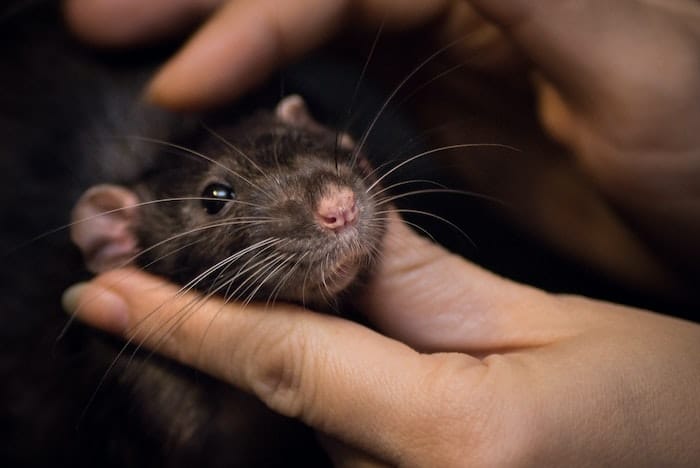
About Pet Rats
Pet rats are small, social mammals that are commonly kept as pets. They have a number of distinctive physical and behavioral characteristics that make them unique and enjoyable pets.
Physical Characteristics:
- Size: Pet rats are small mammals, with an average body length of 7-9 inches, and a tail length of 7-10 inches. They typically weigh between 7-12 ounces.
- Coat: Pet rats have smooth, soft fur that can come in a variety of colors and patterns, including black, brown, white, grey, and various shades in between.
- Tail: Pet rats have long, hairless tails that are used for balance and communication.
- Ears: Pet rats have large, sensitive ears that can move and rotate to help them hear sounds from all directions.
- Snout: Pet rats have a distinctive snout that is moist and sensitive, which they use for exploring and finding food.
Behavioral Characteristics:
- Social: Pet rats are social animals and do best when kept in pairs or small groups. They enjoy playing and cuddling with their cage-mates.
- Curious: Pet rats are naturally curious animals and enjoy exploring their environment. They are also known for being playful and entertaining.
- Affectionate: Pet rats are affectionate animals that can form strong bonds with their owners. They enjoy being handled and will often seek out attention from their owners.
- Intelligent: Pet rats are intelligent animals that can be trained to do simple tricks and respond to commands.
- Clean: Pet rats are clean animals that groom themselves frequently. They also enjoy dust baths to keep their skin and fur healthy.
Pet rats are unique and interesting pets that make great companions for those who are willing to provide them with proper care and attention. If you’re interested in owning a pet rat, it’s important to research their needs and behavior to ensure that you’re able to provide them with the best possible life.
How to Care for a Pet Rat
Taking care of pet rats is not too difficult, but it does require some attention to their needs. Here are some tips for keeping your pet rat healthy and happy:
- Provide it with proper housing
- Feed it a balanced diet
- Get it adequate exercise
- Monitor its health for issues
- Help it with grooming when needed
- Allowing it to socialize (consider getting a pair)
By following these guidelines, you can provide your pet rat with a comfortable life.
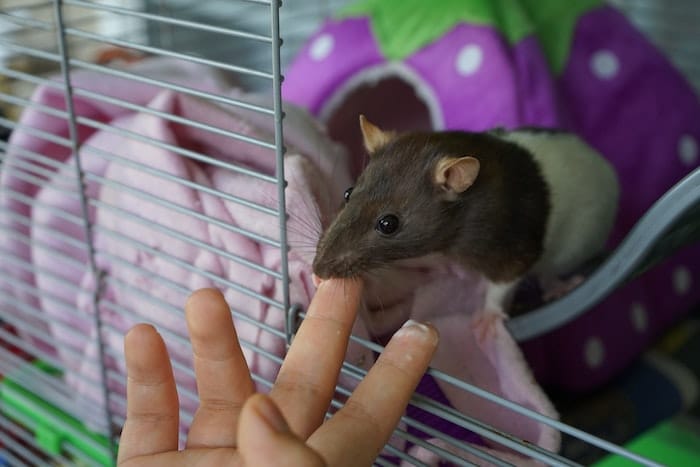
Housing
Pet rats should be kept in a cage that is spacious enough for them to move around, climb, and play. A cage that is 24 inches long by 16 inches wide by 18 inches high is suitable for two to four rats. It is recommended that the cage has a solid floor and sides, and is made of a material that is easy to clean, such as metal or plastic.
Avoid small cages
If a pet rat is not provided with a large enough cage, it can lead to a number of negative consequences for their health and well-being. Some of the most common issues include:
- Lack of exercise: Rats are active animals that need space to move around, climb, and play. If their cage is too small, they won’t have enough room to engage in these activities, which can lead to obesity, muscle wasting, and a decline in their overall health.
- Boredom: Rats are intelligent animals that need mental stimulation to stay happy and healthy. If their cage is too small, they may become bored, which can lead to destructive behavior, such as chewing on the cage, and can also increase stress levels.
- Stress: Rats are social animals that do best when they have enough space to live comfortably with other rats. If their cage is too small, it can cause stress, which can lead to aggressive behavior, suppression of the immune system, and a decline in overall health.
- Respiratory problems: A cage that is too small can cause poor air circulation, which can increase the risk of respiratory problems, such as pneumonia.
- Poor hygiene: A cage that is too small can become overcrowded, making it difficult to keep clean. This can increase the risk of disease and infections.
It’s important to provide your pet rat with a cage that is spacious enough for them to live comfortably, with enough room to move around, play, and interact with other rats. A cage that is 24 inches long by 16 inches wide by 18 inches high is suitable for two to four rats.
Avoid Wire Rung Flooring
Living in a cage with a wire-rung floor can be harmful to a pet rat’s feet. The wire rungs can cause pressure sores on the bottom of their feet, and the small gaps between the rungs can cause their toes to get caught, leading to injury. Over time, the constant pressure on their feet from the wire rungs can also cause calluses to form, which can make it difficult for them to grip and climb. In severe cases, the wire rungs can cause chronic pain and discomfort, making it difficult for pet rats to move around and engage in normal activities.
To prevent these issues, it’s important to provide a soft material, such as aspen shavings or recycled paper, in the bottom of the cage. This will provide a cushion for the rats’ feet and help prevent pressure sores and injuries. Additionally, if you have a cage with wire rungs, it’s important to provide a solid platform for them to rest on and to rotate their bedding regularly to ensure that they have a clean and comfortable place to sleep.
If you notice any signs of injury or discomfort, such as limping, redness, or swelling, it’s important to take your pet rat to a veterinarian as soon as possible.
Diet
A balanced diet for pet rats includes a high-quality commercial rat food that should make up the majority of their diet. This food should contain a balanced combination of proteins, fats, and carbohydrates. Additionally, you can offer your rats fresh fruits and vegetables, such as carrots, apples, and leafy greens, which provide important vitamins and minerals. Offer fresh water every day and provide a heavy water bottle that is difficult for them to tip over.
How Much Food Should a Pet Rat Eat?
The amount of food that a pet rat should eat will depend on several factors, such as their age, size, and activity level. However, a general guideline is to feed your pet rat about 1/8 to 1/4 cup of high-quality rat food per day, divided into two or three meals. It’s important to make sure that the rat food you feed is nutritionally complete and contains all the essential nutrients, vitamins, and minerals that your pet rat needs.
In addition to their regular food, pet rats can also be offered fresh fruits and vegetables as a treat. Some good options include carrots, apples, green beans, lettuce, and cucumber. It’s important to remember that fruits and vegetables should only be offered in moderation, as they can upset the balance of nutrients in your pet rat’s diet.
It’s also important to monitor your pet rat’s weight and adjust their food intake as needed. Rats that are overweight may need to have their food portions reduced, while underweight rats may need to be offered more food.
Foods to Avoid
There are several foods that are not suitable for pet rats and should be avoided to ensure their health and well-being. Some of the most common foods to avoid include:
- Avocados: Avocados contain a toxin called persin that can be toxic to rats and other small animals.
- Chocolate: Chocolate contains theobromine, which can be toxic to rats and cause symptoms such as vomiting, diarrhea, and heart problems.
- Onions and Garlic: Onions and garlic contain sulfoxides and disulfides, which can damage a rat’s red blood cells and lead to anemia.
- Alcohol: Alcohol can be toxic to rats and cause symptoms such as vomiting, diarrhea, and respiratory distress.
- Fatty and sugary foods: Foods that are high in fat or sugar, such as junk food, pastries, and candy, can contribute to obesity and other health problems in rats.
- Foods with high salt content: High-salt diets can lead to dehydration and increase the risk of kidney and heart problems in rats.
- Raw potatoes: Raw potatoes contain solanine, a toxin that can cause symptoms such as vomiting, diarrhea, and tremors in rats.
It’s important to provide your pet rat with a balanced diet that includes high-quality rat food, fresh fruits and vegetables, and limited amounts of treats.
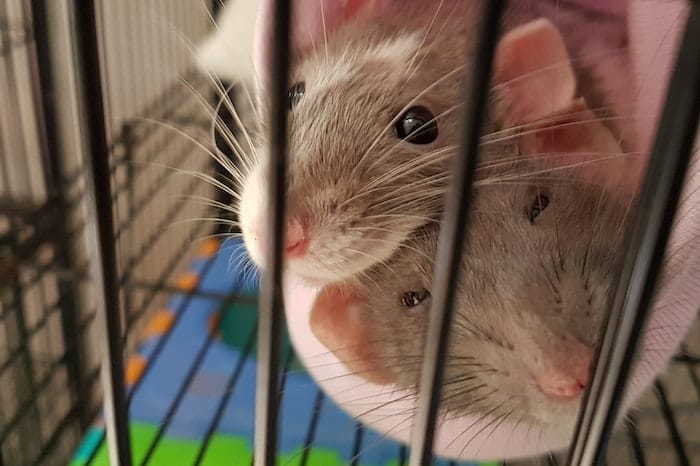
Exercise and Enrichment
Rats are very active and love to play. Providing them with toys, such as ropes and balls, will help keep them entertained and mentally stimulated. Exercise also helps maintain their physical health, keeping their muscles strong and promoting good cardiovascular health. It is recommended that pet rats have at least one hour of playtime outside of their cage every day.
How to safely allow your pet rat to exercise outside of its cage
There are several ways to safely let your pet rat get exercise outside of its cage:
- Rat-proof play area: Designate a specific area in your home where your pet rat can safely play and explore. Make sure to remove any potential hazards, such as loose wires, poisonous plants, and cleaning chemicals. You can also provide toys, tunnels, and climbing structures for your pet rat to play with.
- Exercise wheel: Exercise wheels are a great way for pet rats to get some physical activity. Make sure to choose a wheel that is the appropriate size for your pet rat, with a solid surface and no spokes or wires that could hurt their feet.
- Out-of-cage time: Allow your pet rat to have some out-of-cage time every day, either in a rat-proof play area or supervised in a room in your home. This will give them the opportunity to explore, play, and get some exercise.
- Treadmill: Rats can also use a small, specialized pet rat treadmill for exercise. This is a great option for pet rats that live in a cage with limited space for physical activity.
- Playtime with other rats: Rats are social animals and enjoy playing and exploring with other rats. If you have multiple pet rats, consider letting them play together outside of their cage.
It’s important to always supervise your pet rat when they are outside of their cage to ensure their safety. Also, make sure to provide plenty of hiding places and areas for them to retreat to if they feel scared or overwhelmed.
The Best Enrichment Toys for Pet Rats
Pet rats are active and intelligent animals that enjoy playing and exploring, so providing them with plenty of enrichment toys is an important part of their care. Some of the best toys for pet rats include:
- Tunnels and tubes: Rats love to explore and hide, so tunnels and tubes can be great toys for them. They can crawl through them, hide in them, and play with other rats in them.
- Climbing structures: Rats are good climbers and enjoy exploring elevated areas. You can provide them with climbing structures such as ramps, ladders, and platforms to climb on.
- Chew toys: Rats have a natural urge to chew, so providing them with chew toys can help keep their teeth trimmed and healthy. Some good options include wooden toys, cardboard boxes, and paper-based toys.
- Exercise wheel: Exercise wheels are a great way for pet rats to get some physical activity. Make sure to choose a wheel that is the appropriate size for your pet rat, with a solid surface and no spokes or wires that could hurt their feet.
- Puzzle toys: Rats are intelligent animals that enjoy solving puzzles and challenges. You can provide them with toys such as food-dispensing balls and treat-finding games to keep their minds active and engaged.
- Nests and hideaways: Rats like to have a place to retreat to when they feel scared or overwhelmed, so providing them with a comfortable nest or hideaway can be a great toy. You can make a nest out of a soft material such as a blanket or use a commercially-available rat hideaway.
By providing your pet rat with plenty of enrichment toys, you can help keep them mentally and physically stimulated, which can lead to a happier and healthier life.
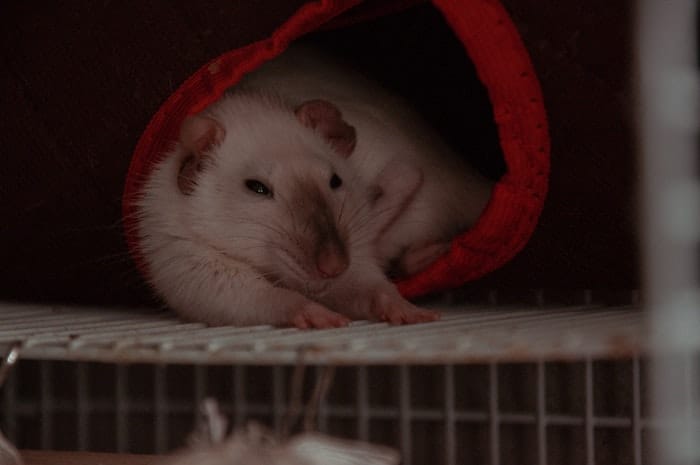
Health
Regular visits to a veterinarian who has experience with rats are important for maintaining your pet’s health. They can check for any signs of illness, such as respiratory infections, tumors, or dental problems, and provide preventive care, such as vaccinations. It is recommended that pet rats have a yearly health checkup and more frequent visits if they are showing any signs of illness.
If you suspect that your pet rat is sick, it’s important to take them to a veterinarian for a diagnosis and treatment.
Signs of Respiratory Infections
Respiratory infections are a common health issue in pet rats, and it’s important to recognize the signs so that you can get them treated promptly. Some of the signs of a pet rat with a respiratory infection include:
- Sneezing: Frequent sneezing is a common symptom of a respiratory infection in pet rats.
- Wheezing: You may hear a wheezing or whistling sound when your pet rat breathes.
- Discharge from the nose or eyes: A pet rat with a respiratory infection may have clear or colored discharge from their nose or eyes.
- Loss of appetite: Rats with a respiratory infection may lose their appetite and not eat or drink as much as usual.
- Lethargy: Your pet rat may become less active and seem lethargic or tired.
- Rapid breathing: If your pet rat is breathing rapidly, this can be a sign of a respiratory infection or other health issue.
- Weight loss: A pet rat with a respiratory infection may lose weight due to their reduced appetite and increased energy expenditure.
Does Your Pet rat have a Tumor or Some Other Type of Lump?
Tumors are a common health issue in pet rats, and it’s important to recognize the signs so that you can get them treated promptly. Some of the signs of tumors in pet rats include:
- Lumps or masses: Tumors in pet rats may appear as lumps or masses under the skin or on the internal organs. They may be hard or soft, and may grow quickly or slowly.
- Changes in behavior: A pet rat with a tumor may display changes in behavior, such as decreased activity or appetite.
- Difficulty breathing: Tumors in the chest or neck can make it difficult for a pet rat to breathe, leading to rapid or shallow breathing.
- Changes in appearance: Tumors may cause changes in the appearance of the pet rat, such as swelling or asymmetry in the face or body.
Other types of lumps or masses in pet rats that could be mistaken for tumors include cysts, abscesses, and fatty tumors (lipomas). These types of lumps may have similar symptoms to tumors, but are treated differently. For example, abscesses are usually treated with antibiotics and surgery, while lipomas are usually benign and do not require treatment unless they are causing discomfort or affecting the pet’s quality of life.
What Types of Teeth Issues Can Pet Rats Get?
Pet rats have continuously growing incisors and molars, and it’s important to provide proper care to keep their teeth healthy and functional. Some of the types of teeth issues that pet rats can have include:
- Overgrown teeth: Pet rats’ incisors and molars can grow too long, leading to malocclusion, discomfort, and difficulty eating.
- Fractured or broken teeth: Pet rats can break or fracture their teeth due to chewing on hard objects or from a fall.
- Abscesses: Abscesses can form in the teeth or gums, causing pain and swelling.
- Infections: Infections in the mouth can cause discomfort and difficulty eating, and can spread to other parts of the body if left untreated.
- Dental tumors: Dental tumors, such as odontomas, can form in the teeth or gums, and may require surgery or other treatments.
Providing your pet rat with a diet that includes gnawing opportunities, such as wooden blocks or other appropriate chew toys, can help to keep their teeth trimmed and healthy. You should also monitor your pet rat’s teeth and gums regularly, and seek veterinary care if you notice any issues or changes.
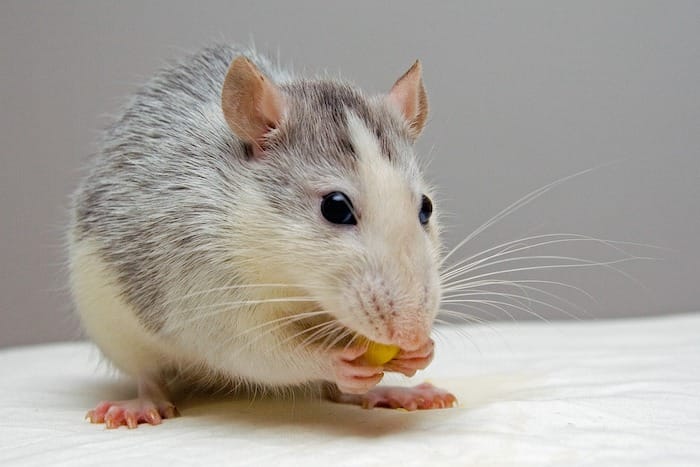
Grooming
Rats are clean animals and keep themselves clean, but it’s still a good idea to provide a dust bath for them every week. This will help keep their fur free of oils and prevent skin problems. You can purchase commercial dust baths specifically designed for rats, or use a mixture of fine sand and baking powder. It’s also important to keep their nails trimmed to prevent any issues with scratching or getting caught in cage wire.
How to Make a Dust Bath
Here’s how you can make your own dust bath for your pet rat:
- Choose a container: You’ll need a container that’s large enough for your pet rat to roll around in and has sides high enough to prevent them from spilling the dust. A plastic bin or shallow cardboard box works well.
- Fill the container with dust: You’ll need a special type of dust specifically designed for pet rats. You can purchase this type of dust, which is usually made of volcanic ash, at pet stores or online. Fill the container with a few inches of dust.
- Offer the dust bath: Place the container inside your pet rat’s cage, and let them explore and use the dust bath as they like. You can offer the dust bath to your pet rat once or twice a week.
- Replace the dust: After your pet rat has used the dust bath, you’ll need to replace the old dust with fresh dust. You can store the used dust for future use, or dispose of it and start with a fresh batch.
Making your own dust bath for your pet rat is a simple and cost-effective way to keep them clean. If you have any concerns or questions about your pet rat’s hygiene or overall health, it’s always a good idea to consult with a veterinarian.
Socialization
Rats are social animals and do best when kept in pairs or small groups. They will bond with each other and enjoy playing and cuddling together. Keeping pet rats in social groups can also reduce stress and increase their overall well-being. It’s important to introduce rats to each other gradually, and to provide enough space in the cage for all of them to live comfortably.
How to Introduce a New Pet Rat Into Your Cage?
Introducing two pet rats can be a process that takes time and patience, but can be rewarding for both you and your rats. Here are the steps to follow when introducing two pet rats:
- Quarantine: Before introducing two pet rats, it’s important to quarantine any new rats for at least two weeks to ensure they’re healthy and free from any diseases that could spread to your existing rats.
- Scent exchange: Place the rats’ cages close to each other so they can smell each other and get used to each other’s scents. You can also swap items like bedding and toys between the cages to help them become familiar with each other’s smells.
- Supervised visits: Once the rats seem comfortable with each other’s scents, you can supervise short visits outside of their cages, keeping an eye out for any signs of aggression or stress.
- Gradually increasing the time: If the visits go well, gradually increase the length of the visits, still being cautious and ready to intervene if needed.
- Final integration: If the visits continue to go well and the rats seem comfortable with each other, you can finally put them in the same cage, but continue to monitor them closely for any signs of aggression or stress.
It’s important to remember that every pair of rats is unique, and the introduction process may take longer or be more complicated for some pairs. If you notice any signs of aggression, it’s important to intervene and separate the rats to prevent injury. If you have any concerns about introducing your pet rats, it’s best to consult with a veterinarian or a professional rat behaviorist for guidance.
Resources
- The Rat Fan Club: The Rat Fan Club is a non-profit organization dedicated to promoting the health and welfare of pet rats. They provide information on rat care, health, nutrition, and behavior, and also offer resources for finding pet rats, supplies, and veterinary care. Website: https://www.ratfanclub.org/
- National Fancy Rat Society: The National Fancy Rat Society is a UK-based organization that provides information on pet rats and fancy rat breeding. They offer a wealth of information on rat care, health, behavior, and shows, and also provide resources for finding pet rats and supplies. Website: https://www.nfrs.org/
- American Pet Rat Association: The American Pet Rat Association is a non-profit organization dedicated to promoting the welfare of pet rats. They provide information on rat care, health, and behavior, and also offer resources for finding pet rats, supplies, and veterinary care. Website: https://www.apra.org/
- RatsPacNW: RatsPacNW is a non-profit organization that provides information and resources for pet rat owners. They offer information on rat care, health, behavior, and nutrition, and also provide resources for finding pet rats, supplies, and veterinary care. Website: https://www.ratspacnw.org/
Pet Rat Forums
- RatForum.com – The largest active community of rat owners and enthusiasts who share information, advice, and personal experiences related to pet rats.
- RatTalk.org – A popular pet rat forum where members can discuss topics such as health, behavior, nutrition, and more.
- PetRats.com – This forum is dedicated specifically to pet rats and offers a supportive and informative community for rat owners and enthusiasts.
Reviewed By: Tim Winter

Tim Winter has a strong affection for pets and wildlife. His years of experience caring for various types of pets has led him to share his knowledge with others on the best practices in pet care. Tim holds a Bachelor of Science from the University of Oregon School of Journalism and Communications.
